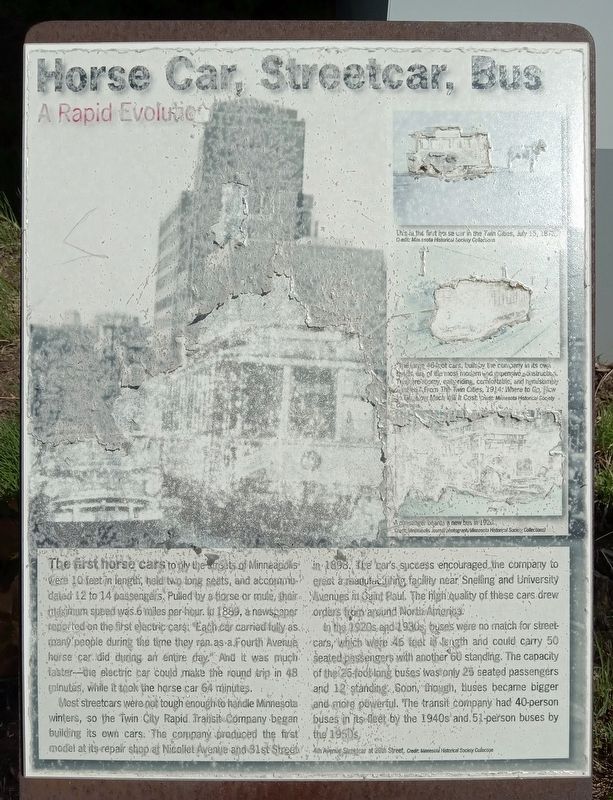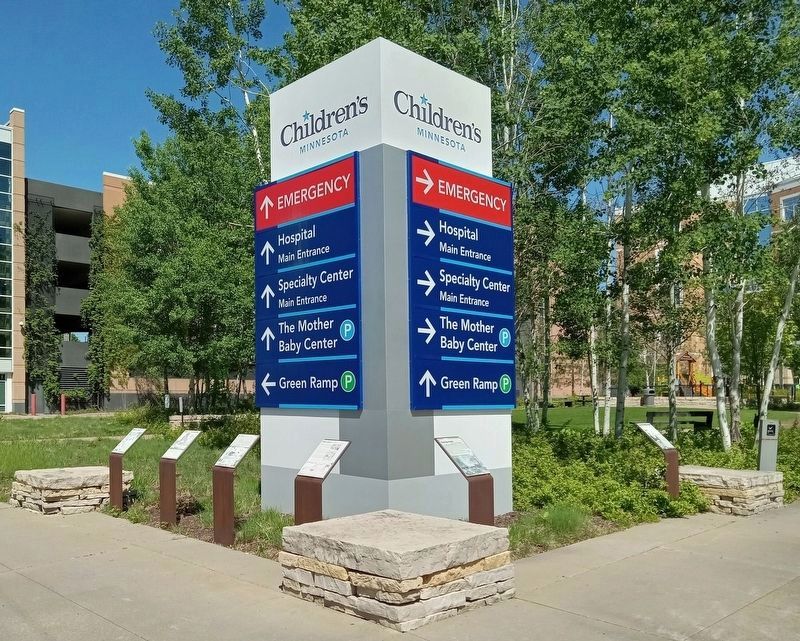Phillips in Minneapolis in Hennepin County, Minnesota — The American Midwest (Upper Plains)
Horse Car, Streetcar, Bus
A Rapid Evolution
This is the first horse car in the Twin Cities, July 15, 1872.
Credit: Minnesota Historical Society Collections
"The large 46-spot cars, built by the company in its own sheds, are of the most modern and expensive construction. They are roomy, easy-riding, comfortable, and handsomely finished." From The Twin Cities, 1914: Where to Go, How to Go, How Much Will It Cost. Credit: Minnesota Historical Society Collections
A passenger boards a new bus in 1923.
Credit: Minneapolis Journal photograph/Minnesota Historical Society Collections)
The first horse cars to ply the streets of Minneapolis were 10 feet in length, held two long seats, and accommodated 12 to 14 passengers. Pulled by a horse or mule, their maximum speed was 6 miles per hour. In 1889, a newspaper reported on the first electric cars: "Each car carried fully as many people during the time they ran as a Fourth Avenue horse car did during an entire day." And it was much faster—the electric car could make the round trip in 48 minutes, while it took the horse car 64 minutes.
Most streetcars were not tough enough to handle Minnesota winters, so the Twin City Rapid Transit Company began building its own cars. The company produced the first model at its repair shop at Nicollet Avenue and 31st Street in 1898. The car's success encouraged the company to erect a manufacturing facility near Snelling and University Avenues in Saint Paul. The high quality of these cars drew orders from around North America.
In the 1920s and 1930s, buses were no match for streetcars, which were 46 feet in length and could carry 50 seated passengers with another 60 standing. The capacity of the 25-foot-long buses was only 25 seated passengers and 12 standing. Soon, though, buses became bigger and more powerful. The transit company had 40-person buses in its fleet by the 1940s and 51-person buses by the 1950s.
4th Avenue Streetcar at 29th Street. Credit: Minnesota Historical Society Collection
Topics. This historical marker is listed in these topic lists: Railroads & Streetcars • Roads & Vehicles. A significant historical year for this entry is 1872.
Location. 44° 57.34′ N, 93° 15.768′ W. Marker is in Minneapolis, Minnesota, in Hennepin County. It is in Phillips. Marker is at the intersection of Chicago Avenue and E. 26th Street, on the right when traveling south on Chicago Avenue. Touch for map. Marker is at or near this postal address: 720 E 26th Street, Minneapolis MN 55404, United States of America. Touch for directions.
Other nearby markers. At least 8 other markers are within walking distance of this marker. Fun Fare (here, next to this marker); Crosstown
(here, next to this marker); Tracking Growth (here, next to this marker); Passed by a Bus (here, next to this marker); The Man Behind the Name (here, next to this marker); An Era of New Business on the Rail Corridor (approx. 0.4 miles away); 2845 10th Avenue South: Elevator X (approx. half a mile away); Minneapolis in the Age of Grade Separation (approx. half a mile away). Touch for a list and map of all markers in Minneapolis.
Credits. This page was last revised on April 22, 2024. It was originally submitted on April 22, 2024, by McGhiever of Minneapolis, Minnesota. This page has been viewed 47 times since then. Photos: 1. submitted on April 22, 2024, by McGhiever of Minneapolis, Minnesota. 2. submitted on February 9, 2024, by McGhiever of Minneapolis, Minnesota.

